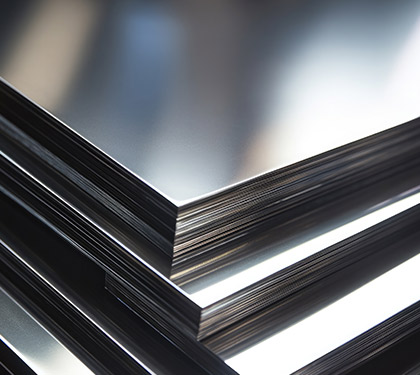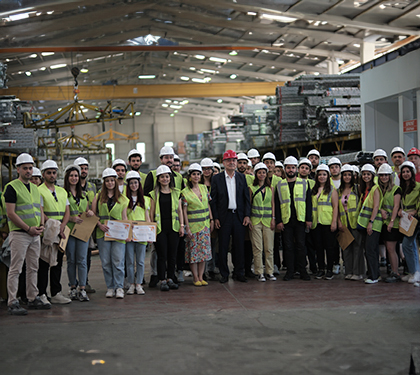What is Aluminum Billet? What are its features?

Aluminum billet is the most basic component in the extrusion process of aluminum and is a semi-product obtained by casting it in the form of a billet, similar to a pipe, in certain lengths and diameters.
Billets can be rectangular, circular or square. Circular billets are generally used in the aluminum extrusion process.
The production of aluminum billets is carried out in foundry facilities, which consist of equipment such as casting lines, melting furnaces and runners, and homogenizing furnaces.
Aluminum billet casting stages in Zahit Aluminum foundry facility can be listed as selection of suitable raw materials, feeding the furnaces according to the content of the alloy to be cast, selection of suitable molds, billet casting with Direct Cooling (DC) casting method, homogenization process of the cast billets and cooling process in cooling furnaces.
How to Use Aluminum Billet?
- Design: Design and planning should be made according to the areas of use of aluminum. In this step, details such as the area where the billet will be used, material size and surface treatment are processed.
- Cutting: The aluminum must be cut to the optimum length for the planned process.
- Shaping: Aluminum billet has different shaping processes for use in different areas. They can be shaped by extrusion, molds and bending processes.
- Drilling: Aluminum has high formability. They can be used by drilling holes at different points and diameters
- Assembly and Welding: Aluminum is generally produced in profile and sheet form. Different profiles allow aluminum to be assembled and used together with its weldability feature.
- Surface Treatment: Unlike other metals, aluminum is a metal suitable for surface treatment. Surface treatments such as anodizing, painting and coating processes are easily applied. Thanks to surface treatments, aluminum products can be used for different visual needs.
How Does Aluminum Billet Take Shape?
Aluminum billets are usually formed by casting, extrusion or pressing. Aluminum is suitable for cold or hot forming. In cold forming method, pressing process is usually performed. In casting, one of the hot forming processes; aluminum billets are heated and poured into a mold and the forming process is completed after cooling. In the extrusion method, after the billet and mold are heated, aluminum billets are pressed into the mold in a predetermined shape under stress with the help of a mechanical or hydraulic press, and the billet takes the shape of the mold.
What are the Features of Aluminum Billet?
Aluminum is used in many different industrial areas with its metallurgical properties. Features of aluminum;
- Light weight: Aluminum shows superior metallic properties despite its low density.
- Corrosion Resistance: Aluminum reacts with oxygen at every stage of production and forms a thin oxide layer on its surface. The oxide layer protects aluminum from the negative effects of atmospheric gases.
- Thermal and Electrical Conductivity: Another metallic property of aluminum is its good thermal and electrical conductivity. The electrical conductivity of aluminum is 36 mega-siemens/m and the thermal conductivity is 205 W/mK. With its high conductivity features, aluminum and its alloys are used in the electrical and electronics industry.
- Recyclability: Aluminum is a metal with a high recovery rate in recycling. Thanks to its low energy consumption in recycling, its usage and recycling rate is quite high.
- Machinability: Another metallic property of aluminum is its high machinability. Thanks to its easy shaping processes, it can be used in many different sectors in different ways.
- Visuality: Aluminum is a metal with a shiny gray color. Apart from its unique appearance, it can be easily applied to surface treatments such as Anodizing and Powder coating.
Where is Aluminum Billet Used?
Aluminum is often used in many different fields due to its properties such as durability, light weight and corrosion resistance. Here are some common uses:
- Transportation Industry: Aluminum is widely used in automotive, air transport, sea transport and rail transport. Aluminum is widely used in engines, vehicle components and many other parts of transportation vehicles.
- Packaging Industry: Aluminum is widely used in beverage cans, food and pharmaceutical packaging with its high oxidation resistance and recyclability. Thanks to its hardness and healthy properties, it is widely used in the food industry.
- Construction Industry: Aluminum is widely used in construction materials. Many structural and decorative components such as windows, doors, facade cladding, stair railings and roofing can be made from aluminum.
- Electrical and Electronic Industry: Thanks to its high thermal and electrical conductivity, aluminum is widely used in resistors, electronic devices and exterior assembly.
- Security and Defense Industry: Aluminum is hard, malleable and lightweight, making it ideal for military vehicles, armored vehicles and other defense applications.
What are the Advantages of Aluminum Billet?
1. Light weight: Aluminum has a very low density compared to other metals. Thanks to its transportation and easy assembly advantages, it is widely used in the construction sector.
2. Durability: One of the most common problems that metals may encounter during the long use phase is the effects of atmospheric gases. Since aluminum is a non-ferrous metal, it does not rust and is highly resistant to atmospheric gases (oxygen and hydrogen etc.) with its metallic properties.
3. Flexibility: Aluminum is a metal with high formability. With this feature, it can be produced in different shapes and sizes.
4. Strength: Aluminum is a metal with high strength despite its low density. It has high structural durability.
5. Low Maintenance Requirement: With its high resistance to rust and corrosion, aluminum billet requires lower maintenance requirements than other metals.
Benzer Haberler

03
Temmuz
What is Aluminum Profile? What are its Usage Areas and Features?


03
Temmuz
Zahit Aluminum participated in Career and Vocational Training Days


03
Temmuz
Where are Aluminum Architectural Systems Used?


03
Temmuz
ZAHİT ALÜMİNYUM HOSTED GUESTS OF UNİVERSITY


